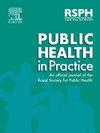Syndemic geographic patterns of cancer risk in a health-deprived area of England
IF 1.9
Q2 PUBLIC, ENVIRONMENTAL & OCCUPATIONAL HEALTH
引用次数: 0
Abstract
Objectives
This study aims to analyse the geographical co-occurrence of cancers and their individual and shared risk factors in a highly deprived area of the North West of England to aid the identification of potential interventions.
Study design
An ecological study design was employed and applied at postcode sector level in the Morecambe Bay region.
Methods
A novel spatial joint modelling framework designed to account for large frequencies of left-censored cancer data was employed. Nine cancer types (breast, colorectal, gynaecology, haematology, head and neck, lung, skin, upper gastrointestinal, urology) alongside demographic, behavioural factors and socio-economic variables were included in the model. Explanatory factors were selected by employing an accelerated failure model with lognormal distribution. Post-processing included principal components analysis and hierarchical clustering to delineate geographic areas with similar spatial risk patterns of different cancer types.
Results
15,506 cancers were diagnosed from 2017 to 2022, with the highest incidence in skin, breast and urology cancers. Factors such as age, ethnicity, frailty and comorbidities were associated with cancer risk for most of the cancer types. A positive geographical association was found mostly between the colorectal, haematology, upper GI, urology and head and neck cancer types. That is, these cancers had their largest risk in the same areas, similarly to their lowest risk values. The spatial distribution of the risk and cumulative risk of the cancer types revealed regional variations, with five clusters identified based on cancer type risk, demographic and socio-economic characteristics. Rural areas were the least affected by cancer and the urban area of Barrow-in-Furness was the area with the highest cancer risk, three times greater than the risk in the surrounding rural areas.
Conclusions
This study emphasizes the utility of joint disease mapping by geographically identifying common or shared factors that, if targeted, could lead to reduced risk of multiple cancers simultaneously. The findings suggest the need for tailored public health interventions, considering specific risk factors and socio-economic disparities. Policymakers can utilize the spatial patterns identified to allocate resources effectively and implement targeted cancer prevention programmes.
英格兰健康贫困地区癌症风险的综合地理模式
研究设计在莫克姆湾地区的邮政编码部门层面采用了生态研究设计。研究方法采用了新颖的空间联合建模框架,该框架旨在考虑大量左删失癌症数据的频率。模型包括九种癌症类型(乳腺癌、结直肠癌、妇科、血液学、头颈部、肺癌、皮肤癌、上消化道癌、泌尿科)以及人口、行为因素和社会经济变量。通过采用对数正态分布的加速失败模型来选择解释因素。后处理包括主成分分析和分层聚类,以划分出不同癌症类型具有相似空间风险模式的地理区域。结果 2017 年至 2022 年期间诊断出 15506 例癌症,其中皮肤癌、乳腺癌和泌尿科癌症的发病率最高。年龄、种族、虚弱程度和合并症等因素与大多数癌症类型的癌症风险有关。在结直肠癌、血液病、上消化道癌症、泌尿科癌症和头颈部癌症之间,发现了一种积极的地域关联。也就是说,这些癌症在相同地区的风险最大,而在相同地区的风险值最低。癌症类型风险和累积风险的空间分布显示了地区差异,根据癌症类型风险、人口和社会经济特征确定了五个群组。农村地区受癌症的影响最小,而巴罗因弗内斯的城市地区则是癌症风险最高的地区,是周边农村地区的三倍。结论这项研究强调了联合疾病绘图的实用性,通过地理位置确定共同或共享的因素,如果有针对性,可以同时降低多种癌症的风险。研究结果表明,考虑到特定的风险因素和社会经济差异,有必要采取有针对性的公共卫生干预措施。政策制定者可以利用确定的空间模式有效分配资源,实施有针对性的癌症预防计划。
本文章由计算机程序翻译,如有差异,请以英文原文为准。
求助全文
约1分钟内获得全文
求助全文

 求助内容:
求助内容: 应助结果提醒方式:
应助结果提醒方式:


